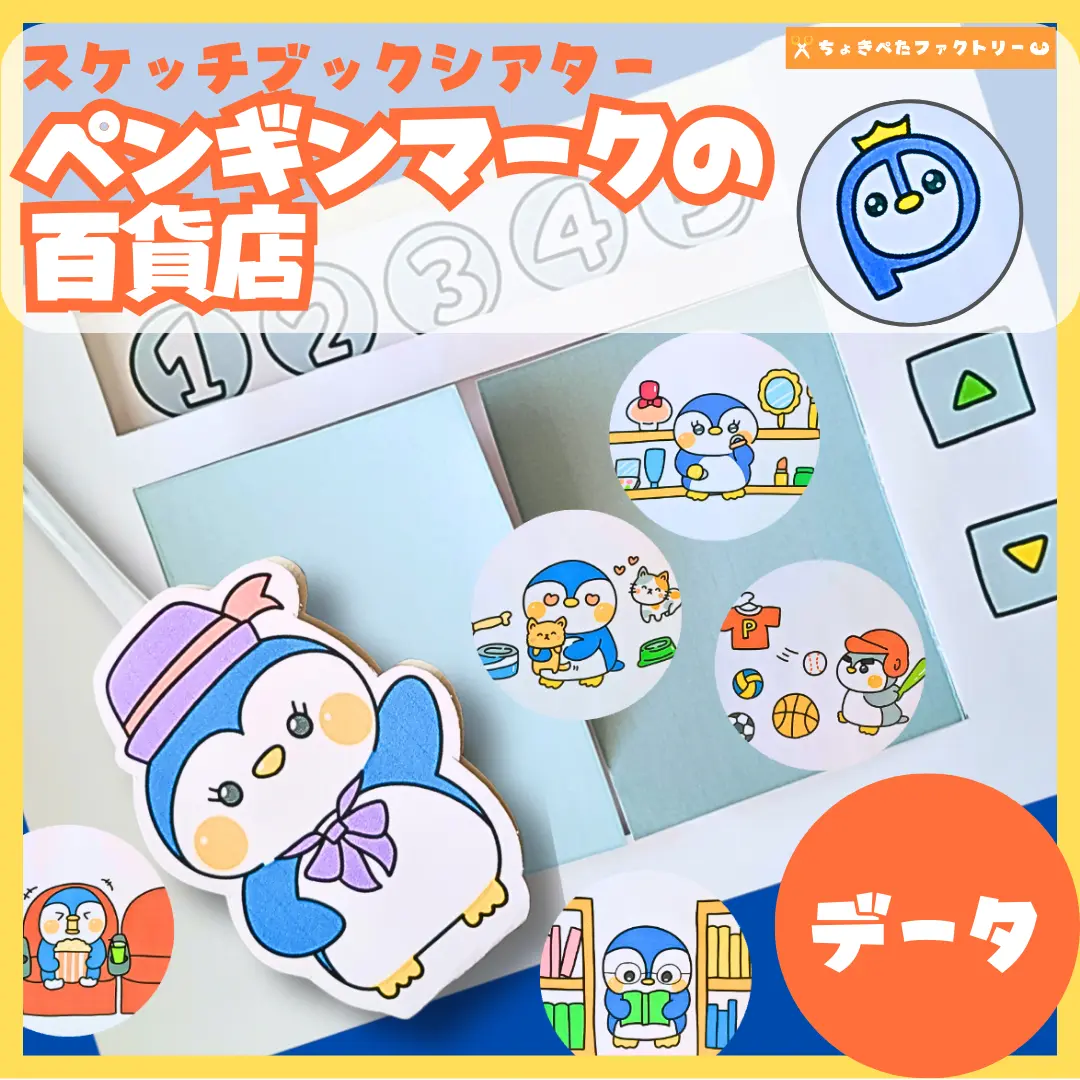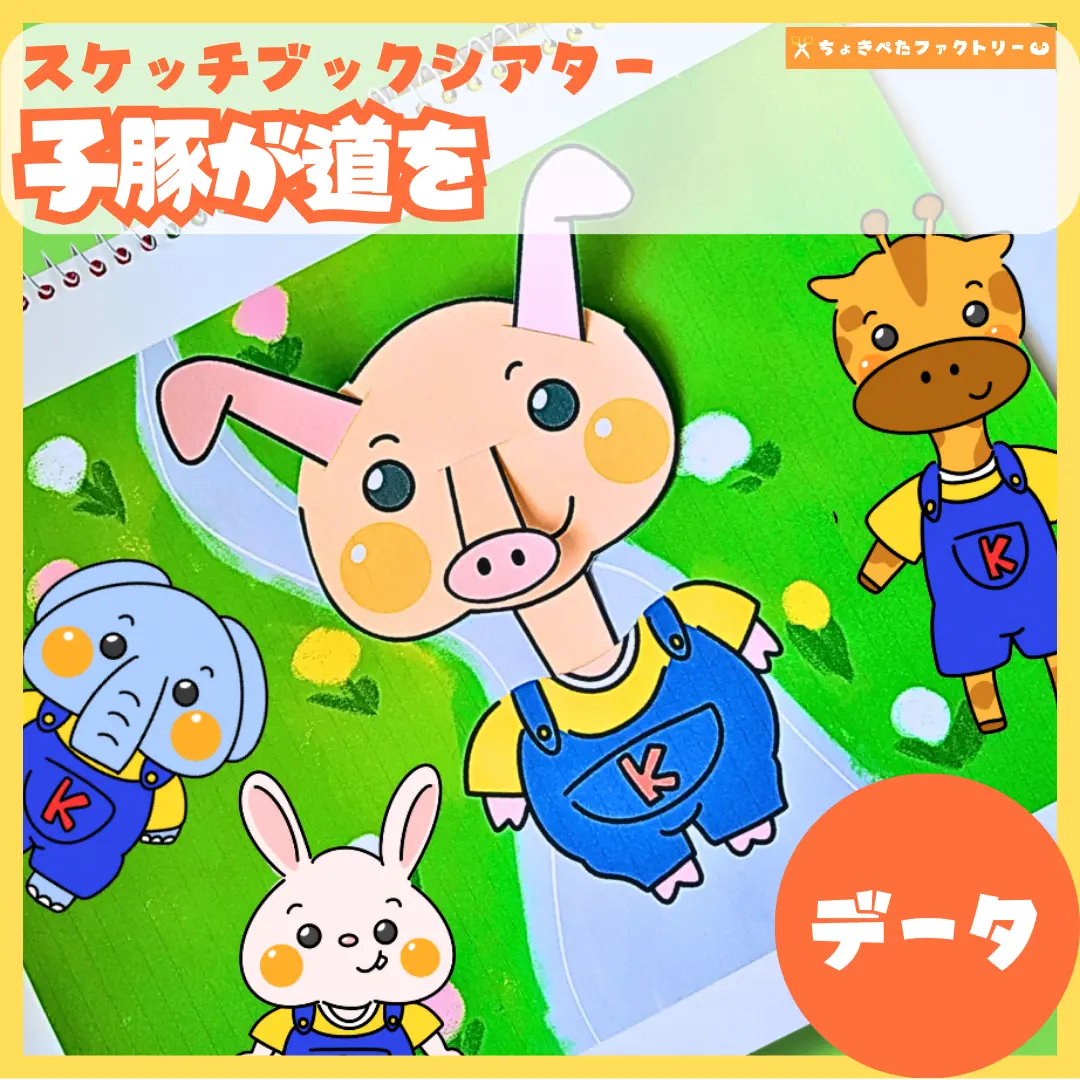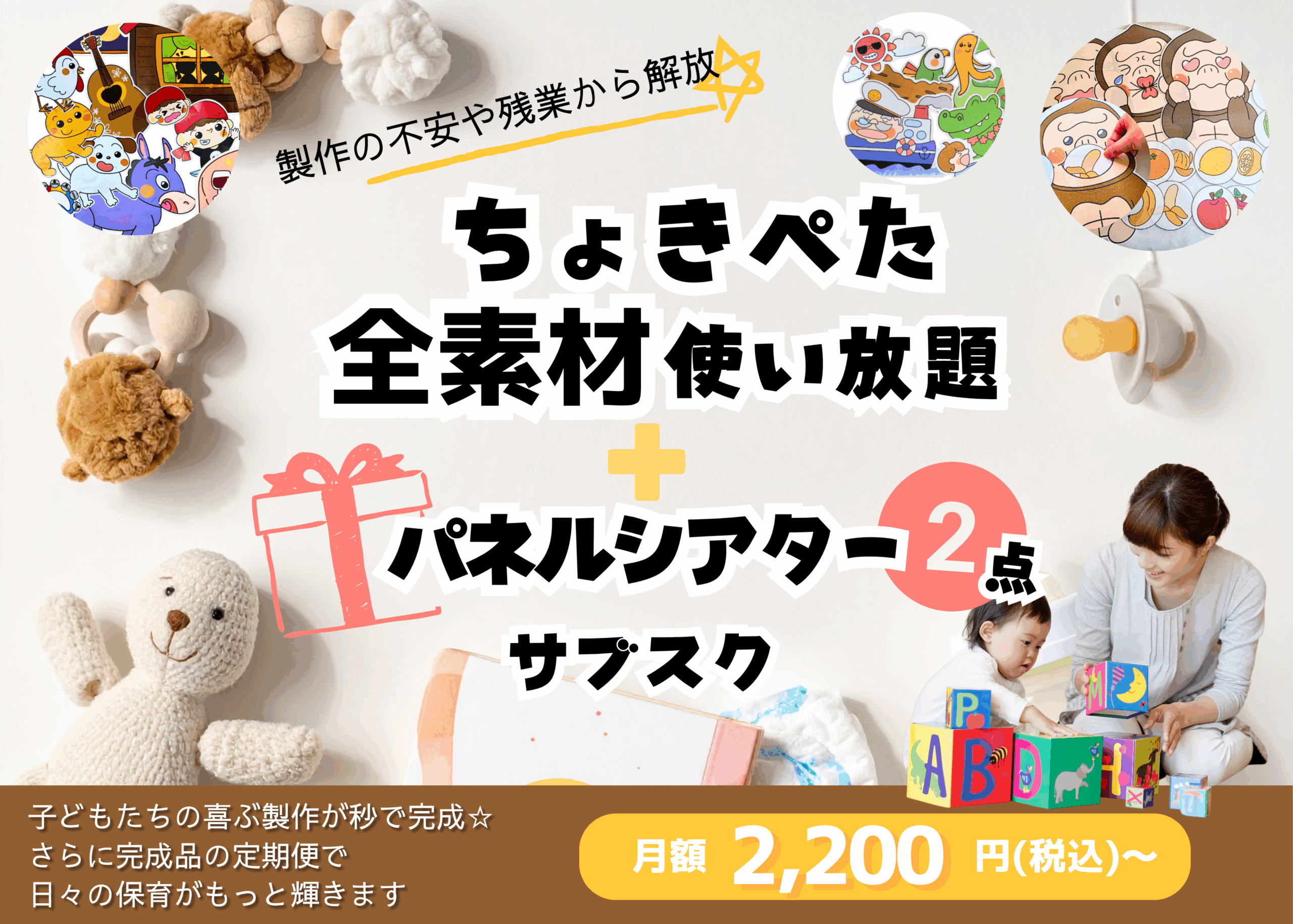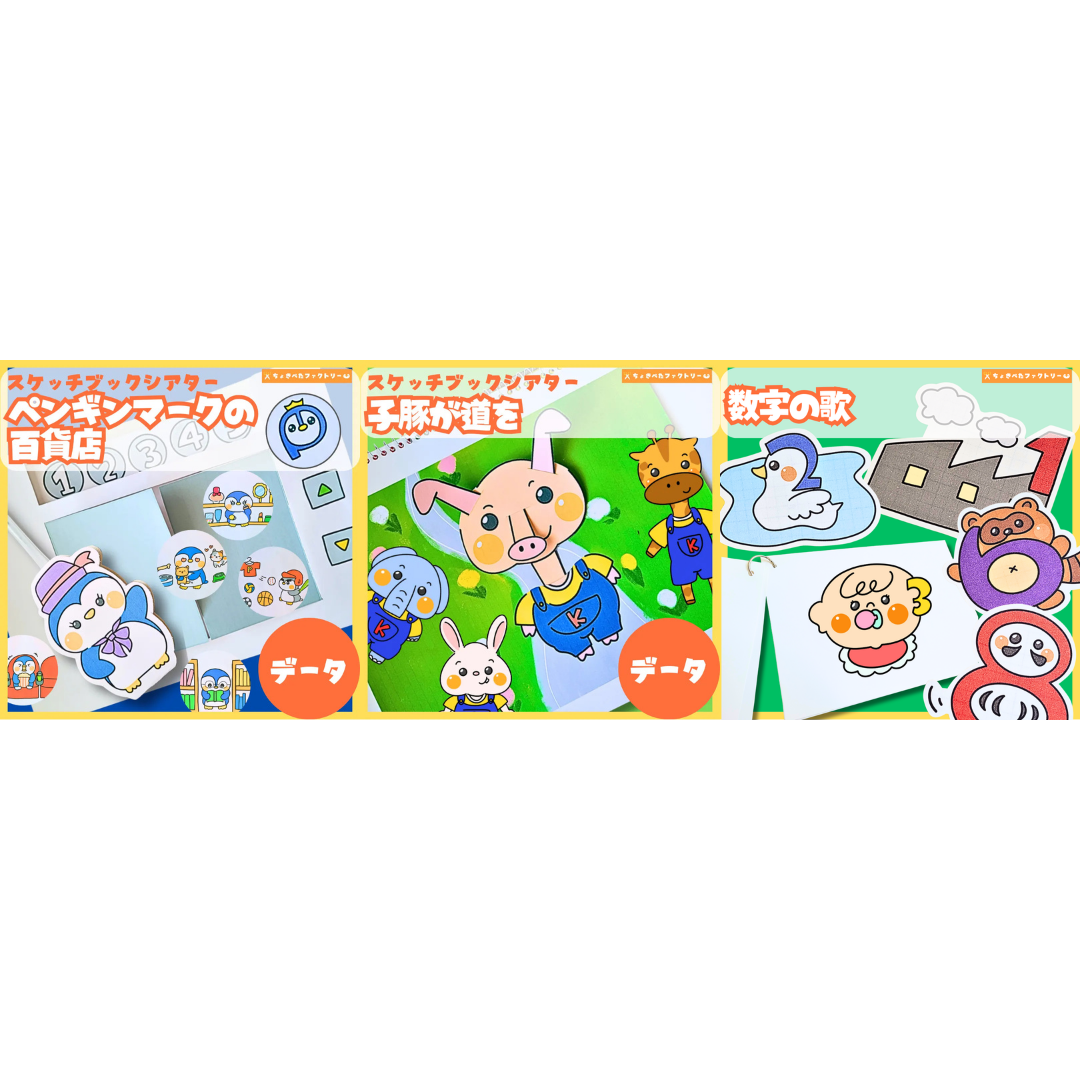スケッチブックシアターとは、スケッチブックを使用して手軽に作れる保育教材の1つです。
めくったり、仕掛けを動かしたりして演じます。
この記事では、保育士さんや保育学生さんがスケッチブックシアターを製作・使用する上で知っておくべき情報をまとめて解説します!
- スケッチブックシアターとは
- スケッチブックシアターのメリット
- スケッチブックシアターの実演方法
- スケッチブックシアターの製作が上手になる方法
- スケッチブックシアターを使うべきタイミング
- 子どもに人気のスケッチブックシアター
スケッチブックシアターとは?
スケッチブックシアターは、スケッチブックを用いて物語を進行するシアターです。
ページ毎に物語の一部を描き出し、それを順にめくって演じます。
基本文字がないので、紙芝居のようにイラストに沿って語りながら進行していきます。
さらに、工夫次第で「クイズ形式」など子どもたち参加型のコンテンツとしても活用されています。

作り方や演じ方次第で、
多様な活用ができるのが魅力だね!
スケッチブックシアターを保育現場で活用するメリット
保育教材として主流なのは「ペープサート」や「パネルシアター」です。
この2つに比べスケッチブックシアターは、
あまりメジャーな教材の印象がないですよね。
ですが!
実は使い勝手が良く、
実際に使っていて現場でかなり重宝していました☆
パネルシアターやペープサートとの違い

そもそも他の教材と何が違うの?
と言うことで、簡単に各教材の特徴をまとめてみました。
| スケッチブックシアター | パネルシアター | ペープサート | |
|---|---|---|---|
| 印刷媒体 | 普通紙 | 不織布 | 普通紙 |
| 掲載媒体 | スケッチブック | 不織布 | 割り箸 |
| 実演方法 | スケッチブックを捲る | パネルに貼る | 手で持って動かす |
| 対象人数 | 1〜10人 | 10人以上 | 1〜5人 |
スケッチブックや普通紙を使って手軽に作成でき、
大きさを調整数れば少人数から大人数まで楽しめる教材ということが分かります。
つまりスケッチブックシアターは、
「パネルシアター」と「ペープサート」の良さをいいとこ取りしているんです!
スケッチブックシアターの目的と効果
スケッチブックシアターは、
目的に合わせて活用することで
さまざまな効果を発揮してくれます。
目的と効果について、詳しくみていきましょう!
子どもたちの視線を集める
スケッチブックシアター活用の最大の目的は「子どもたちに注目してもらう」ことです。
演じ手の体の前で収まるサイズなので、より子どもたちの視線を集められます。
活動の前に取り入れることで、
子どもたちは気持ちを切り替えて次の活動をスタートできます。
言語能力と聴解能力の発達促進
スケッチブックシアターは絵本とは違い
文字がありません。
子どもたちは演じ手の言葉に耳を傾けることで、
言葉に興味を持ったり、知ったりします。
また見て聞くを同時に行うことで、
言葉の意味を少しずつ理解するようになります。
集中力と記憶力の向上
文字がない利点はもう1つあります。
イラストをじーっと集中して見ることができ、
子どもたちの集中力を高めることもできます。
さらに何度か演じることで、

次はこうなる!
と展開を思い出すので記憶力も高まります。
毎日同じシアターをするのは
子どもたちの飽きに繋がるので、適度に日にちを空けてやっていきましょう!
スケッチブックシアターの準備
スケッチブックシアターを作成・演じる前に、
準備をしていきましょう!
目的をもって子どもたちに楽しんでもらえるよう
まずはどのようなスケッチブックシアターにするのかを考えていきます。
スケッチブックシアターをやる目的(ねらい)を明確にする
スケッチブックシアターを作成する際には、
まず目的やねらいを明確にすることが重要です。
目的は、
- 子どもたちに何を伝えたいのか
- どのような体験を提供したいのか
- どのような能力を身につけてもらいたいか
を明確にするものです。
目的を明確にすることで、
テーマの選定、ストーリーの作成などを効果的に進めることができます。
スケッチブックシアターのテーマの選定
続いて、テーマの選定です。
テーマは物語の中心となる要素で、子どもたちの興味を引きつけるための重要な部分です。
テーマは幅広くざっくりでOKですが、
2〜3個の要素を組み合わせると良いです。
取り入れたい要素をいくつか出し、
また、
- 季節や行事に合わせてテーマを決める
- 主活動の内容に合わせてテーマを決める
(例:動物園、食育活動、どんぐり拾い)
のもおすすめです!

やりたいことがいっぱいで決められないな…

ピンとくるテーマが思いつかない…
と言う際には、
もう一度「目的(ねらい)を明確にする」に戻ってみましょう。
スケッチブックシアターのストーリーの作成
次に、選んだテーマに基づいてストーリーを作成します。
基本的にストーリーはシンプルで分かりやすいものを目指しましょう。
また、子どもたちの年齢や発達にも配慮していきたいです。
さらに!
子どもたちが参加できる要素を追加するのもおすすめです。
スケッチブックに絵を描く準備をしよう
ストーリーが決まったら、
簡単にイラストを描いてみましょう!
最初からスケッチブックに描くと失敗の可能性もあるので、
まずは別の紙に描いていきます。
(ノートでも、いらない裏紙でもなんでもOK)
まずは
- 登場人物
- 背景
- 小物
など、必要そうなイラストをざっくり描きます。
次にどこからどこまでのストーリーを1ページに盛り込むかを
考えましょう。
ある程度構図が決まったら、
ざっくりと完成っぽい絵を描いてみます。

イラスト描くの苦手だな〜…
という方は、ちょきぺたイラストを使ってみてください!
必要な材料と道具
イラストができたら、
道具を準備して作成していきましょう!
まず、スケッチブックは必要ですね。
サイズは自由に選べますが、
大きめのものを選ぶと絵が描きやすく、
視聴者にも見やすいです。
その他の道具は、作り方に応じて異なるので
作成前にしっかり確認して準備しましょう。
下記に作り方に応じた基本的な準備物をまとめておきます。
直接絵を描く場合:ペンやクレヨン、下書きするなら鉛筆消しゴム
イラストを貼る場合:イラスト素材、画用紙、はさみ、のり、両面テープ
仕掛けをつける場合:(イラストを貼る場合)に加えて、カッター
スケッチブックシアターの実演方法
完成したら、早速演じてみましょう。
と、その前に!
たくさんの準備が無駄にならないように、
演じ方をチェックして練習しておきましょう!
スケッチブックシアターの基本的な演じ方
基本的には、スケッチブックを1枚ずつめくりながら進めていきます。
絵本のように文字がないので、
見せているイラストにあったセリフやナレーションをしながら
演じていきましょう。
仕掛けのあるものの場合は、
ごたつかないように操作しながら
演じていきます。
よりスムーズに演じられるように
事前に操作確認や練習を行っておくのがおすすめです。
効果的なストーリーテリングのテクニック
ストーリーテリングとは、
物語や体験談を通して、相手に伝えたい思いを伝えて
印象付ける手法のことです。
保育においては子どもたちの想像力をさらに刺激し、
言葉の理解を深めるための重要な方法ともなります。
ストーリーテリングのメリット
以下に、保育におけるストーリーテリングの主な利点を紹介します。
- 言葉の理解と語彙力の向上
ストーリーテリングは、子どもたちに新しい言葉や表現を教える絶好の機会です。
また、物語を通じて言葉の意味や使い方を理解することで、子どもたちの語彙力が向上します。 - 想像力と創造力の育成
物語は、子どもたちに異なる人々や場所、状況について考える機会を提供します。
これにより、彼らの想像力と創造力が育まれます。 - 感情の理解と表現
ストーリーテリングを通じて、子どもたちは様々な感情や感情の表現方法を学びます。
また、物語のキャラクターが経験する感情に共感することで、
自分自身の感情を理解し、適切に表現する能力を養います。 - 集中力と聞き取り能力の向上
物語を聞くことは、子どもたちの集中力を鍛え、聞き取り能力を向上させます。
保育現場でのストーリーテリング活用について
保育現場では主に
「昔話」やイソップ物語を中心とする「寓話」を題材に
この手法を活用しています。
物語を楽しんだのち、

楽して作ったおうちはすぐ壊れちゃったね…
どうしたらよかったのかな?
(例:「3びきのこぶた」)
と言うような問いかけや語りかけを行い、
子どもたちの考える力を刺激しましょう!
子どもたちの参加を促す方法
スケッチブックの中には子どもたち「参加型」のものもあります。
分かりやすいのが、クイズ形式のものです。

これはなんだろう?
と問いかけながら進めていくことで
遊び感覚で楽しめます。
年齢別スケッチブックシアターの活用方法
スケッチブックシアターの活用方法を0〜5歳児を対象にして、まとめてみました。
0〜1歳児のスケッチブック活用
この年齢の子どもたちは、色彩や形、動きに反応します。
そのためシンプルな絵やパターン、
鮮やかな色を使用したスケッチブックを作成しましょう。
さらに、それをめくることで視覚的な刺激を体験できます。
また絵を指して見せることで、視覚と聴覚の連携を促します。
2〜3歳児のスケッチブック活用
この年齢の子どもたちは、基本的な物語の概念を理解し始めます。
また、物語を通して言葉や登場人物に興味をもっていきます。
まずは、簡単な物語を含むスケッチブックシアターを選びましょう。
そして物語に登場するキャラクターやアイテムを
指して名前を伝えることも有効的です。
4〜5歳児のスケッチブック活用
この年齢の子どもたちは、より複雑な物語を理解する能力を持っています。
さらに物語を通して、創造力と表現力を育てます。
物語だけでなくクイズ形式にすることで、
物事への理解を深め、考える力を鍛えることもできます。
ちょきぺたファクトリーのスケッチブックシアターを紹介!
最後に、ちょきぺたファクトリーが提供するパネルシアターの素材をご紹介します!
第2位:ペンギンマークの百貨店

第2位は、「ペンギンマークの百貨店」でした!!
※このイラスト素材は手遊び歌を元に作成しております。
エレベータガールさんが
噂の百貨店を案内してくれます。
それぞれの階にはどんなものが売ってあるのかな??
どっきんどっきんわくわく〜なお歌スケッチブックシアターです。
演じる際には、
紙芝居のように紙を1枚ずつ抜いていきます。
その後エレベーターの扉を開けて、フロアを見せます。
エレベーターガールのペンギンさんは、
ペープサートの要領で作成しましょう!

ご案内しま〜す!
と、なりきって演じてみてくださいね♡
| 実演時間 | 5分程度 |
| 季節 | 通年 |
| あらすじ | エレベーターガールさんがペンギンの百貨店をご案内します! |
第1位:こぶたが道を

第1位は、「こぶたが道を」でした!!
※このイラスト素材は手遊び歌を元に作成しております。
こぶたさんが楽しくお散歩していると素敵な誘惑が…
だんだん鼻が伸びて…ゾウさんになったり
ウサギやキリンに変身しちゃう…
と見せかけて、ウソ!というオチありのお歌スケッチブックシアターです。
歌に合わせて鼻、耳、首の仕掛けを動かして演じてみてください。
| 実演時間 | 3分程度 |
| 季節 | 通年 |
| あらすじ | こぶたが道を歩いてると、誘惑に誘われて別の動物に変身しちゃうかも? |
【まとめ】スケッチブックシアターとは
スケッチブックシアターとは、スケッチブックを使用して作成したシアターです。
パネルシアターやペープサートの良さを兼ね備えており、
準備や保管がしやすいことも魅力です。
ご自宅でスケッチブックシアターを作成するには、
スケッチブックやペンなど準備が必要です。
また、イラストを描くとなると
子どもたちに伝わる絵を描く力も必要になります。
ちょきぺたファクトリーでは保育士のみなさまの負担を軽減するために、
スケッチシアターのアイデアや素材を掲載できたらと考えています。

便利な教材が欲しいけど、
作る時間がないな…
という方はぜひ、
ちょきぺたファクトリー会員サービスのご利用をご検討ください!



